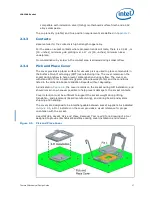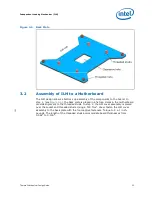
LGA1366 Socket and ILM Electrical, Mechanical, and Environmental Specifications
28
Thermal/Mechanical Design Guide
4.4
Loading Specifications
The socket will be tested against the conditions listed in the LGA1366 Socket Validation
Reports with heatsink and the ILM attached, under the loading conditions outlined in
this chapter.
Table 4-3
provides load specifications for the LGA1366 socket with the ILM installed.
The maximum limits should not be exceeded during heatsink assembly, shipping
conditions, or standard use condition. Exceeding these limits during test may result in
component failure. The socket body should not be used as a mechanical reference or
load-bearing surface for thermal solutions.
Notes:
1.
These specifications apply to uniform compressive loading in a direction perpendicular to the IHS top
surface.
2.
This is the minimum and maximum static force that can be applied by the heatsink and it’s retention
solution to maintain the heatsink to IHS interface. This does not imply the Intel reference TIM is validated
to these limits.
3.
Loading limits are for the LGA1366 socket.
4.
This minimum limit defines the compressive force required to electrically seat the processor onto the socket
contacts.
5.
Dynamic loading is defined as an 11 ms duration average load superimposed on the static load
requirement.
6.
Test condition used a heatsink mass of 550 gm [1.21 lb] with 50 g acceleration measured at heatsink mass.
The dynamic portion of this specification in the product application can have flexibility in specific values, but
the ultimate product of mass times acceleration should not exceed this dynamic load.
4.5
Electrical Requirements
LGA1366 socket electrical requirements are measured from the socket-seating plane of
the processor to the component side of the socket PCB to which it is attached. All
specifications are maximum values (unless otherwise stated) for a single socket
contact, but includes effects of adjacent contacts where indicated.
Table 4-3.
Socket and ILM Mechanical Specifications
Parameter
Min
Max
Notes
Static compressive load from ILM cover to
processor IHS
445 N [100 lbf]
623 N [140 lbf]
3
,
4
Heatsink Static Compressive Load
0 N [0 lbf]
266 N [60 lbf]
1
,
2
,
3
Total Static Compressive Load
(ILM plus Heatsink)
445 N (100 lbf)
890 N (200 lbf)
3
,
4
Dynamic Compressive Load
(with heatsink installed)
N/A
890 N [200 lbf]
1
,
3
,
5
,
6
Target Pick and Place Cover allowable removal
force
N/A
4.45 - 6.68 N [1.0 -
1.5 lbf]
Load Lever actuation force
N/A
38.3 N [8.6 lbf] in the
vertical direction
10.2 N [2.3 lbf] in the
lateral direction.
Summary of Contents for X5550 - Quad Core Xeon
Page 8: ...8 Thermal Mechanical Design Guide ...
Page 12: ...Introduction 12 Thermal Mechanical Design Guide ...
Page 24: ...Independent Loading Mechanism ILM 24 Thermal Mechanical Design Guide Figure 3 3 ILM Assembly ...
Page 26: ...Independent Loading Mechanism ILM 26 Thermal Mechanical Design Guide ...
Page 48: ...Component Suppliers 48 Thermal Mechanical Design Guide ...
Page 82: ...Mechanical Drawings 82 Thermal Mechanical Design Guide ...
Page 88: ...Socket Mechanical Drawings 88 Thermal Mechanical Design Guide ...















































